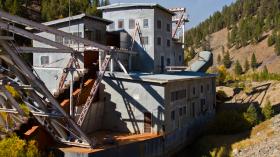forum
library
tutorial
contact

Salmon the Focus of Northwest Rivers Initiative
by Aaron KunzNorthwest Public Radio, October 30, 2012
|
the film forum library tutorial contact |

|
Salmon the Focus of Northwest Rivers Initiativeby Aaron KunzNorthwest Public Radio, October 30, 2012 |
 Dams, agriculture, urban development -- they've all contributed to the loss of quality habitat for Northwest salmon. EarthFix reporter Aaron Kunz recently visited an Idaho river where a historic gold mine has left problems behind for salmon and steelhead. Here's his report on what's being done to clean things up.
Dams, agriculture, urban development -- they've all contributed to the loss of quality habitat for Northwest salmon. EarthFix reporter Aaron Kunz recently visited an Idaho river where a historic gold mine has left problems behind for salmon and steelhead. Here's his report on what's being done to clean things up.
The Salmon River is one of the longest free-flowing rivers in the Pacific Northwest. The mountains, clean water and abundant fish and wildlife have attracted hundreds of people like Jerry Meyers, who calls this place home.A
Meyers: "Personally we've in my family had a long history of enjoying all the attributes of having all the healthy salmon and steelhead for many years and basically we love to fish."
Jerry Meyers is an outfitter - guiding summer visitors down the Salmon River in search of a good fishing hole. He has seen salmon numbers drop since he first started fishing the river as a teenager in the early 1960s.
Meyers: "And even back then it was a concern to me and it first got me active in conservation and thinking about what long-term effects that we can have on the environment that we all love so much."
While there are many reasons for the decline of salmon and steelhead, Meyers says one reason is poor habitat for fish. In this corner of the Northwest, it's Idaho's gold mining past that has salmon and steelhead in trouble today.
In the mid to late 1800s, miners came here to Idaho's central mountains in search of gold. In the first half of the 1900s, miners used building-sized machines to move large sections of earth in search of valuable minerals. Bart Garnett is with the U.S. Forest Service.
Garnett: "A very large dredge would dig up the material on the valley floor and then process it to extract the gold and then dump the excess material out the back in these dredge piles that you see along the valley floor here."
The Yankee Fork valley used to be full of trees and brush with a winding river down the middle. It empties into the upper Salmon River near Stanley.
Dredge mining operations stopped here by 1960. But their legacy remains.
Today, the Yankee Fork of the Salmon River runs through miles of barren rock piles with few trees. It has become the poster child for the effects of dredge mining. The mining caused the river to be straightened, the trees and plants were removed.
The Shoshone-Bannock Tribe did some temporary work here in the 1990's to benefit the fish. At the turn of the century, several federal and state agencies decided to team up with the tribe and do more permanent repairs. The goal is to restore salmon and steelhead habitat that's friendlier for young fish, so they can bulk up for their big trip to the Columbia River and past its dams to the Pacific Ocean. Paul Drury represents one of the partners - the U.S. Bureau of Reclamation.
Drury: "One of the limiting factors on the Yankee Fork is rearing habitat for our endangered juvenile chinook salmon. So we are creating a desirable rearing habitat for the juvenile chinook."
The $1.3 million restoration project will connect several old dredge ponds to the Yankee Fork. To do this - large tractors are removing rocks and gravel to make way for a side channel.
The additions will put some curves back into the river. It will provide slow moving water lined with trees and willows to offer the salmon protection from raptors like eagles and osprey. Again, here's Paul Drury.
Drury: "That increased habitat value will add to their robustness and condition for an out migration to the ocean.'
Projects like this are being done around the Northwest using money from the Bonneville Power Administration. Part of the billion dollar pot of money used to compensate for the impacts of eight federal dams along the Columbia and Snake Rivers.
Most projects this size take years to break ground. One problem is gaining access to private property. Part of the land at this restoration site is owned by the JR Simplot Company. The partners in this project say instead of throwing up roadblocks, Simplot pitched in.
They say that's a big reason this project is well underway in just over a year. That despite several setbacks including wildfires this summer that kept contractors from starting work until September.
Again, Bart Garnett with the U.S. Forest Service.
Garnett: "The bottom line is -- without the collaborative effort with all of the partners working on it, this would have never happened."
This project has the blessing and the financial backing of the federal government's America's Great Outdoors Rivers Initiative. It is sponsoring one major project in each of the fifty states plus the District of Columbia. The Elwha River in Washington and the Sandy River in Oregon are the other projects taking place in the Northwest.
learn more on topics covered in the film
see the video
read the script
learn the songs
discussion forum
